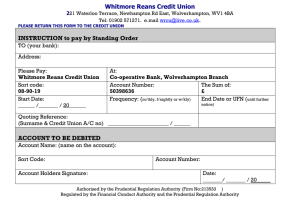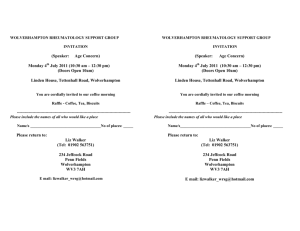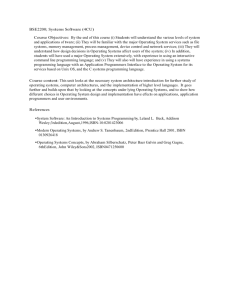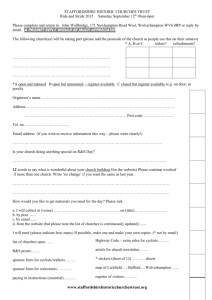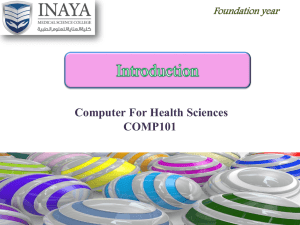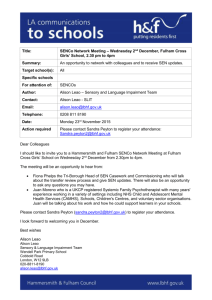CP1007 Visual Basic Programming 1
advertisement
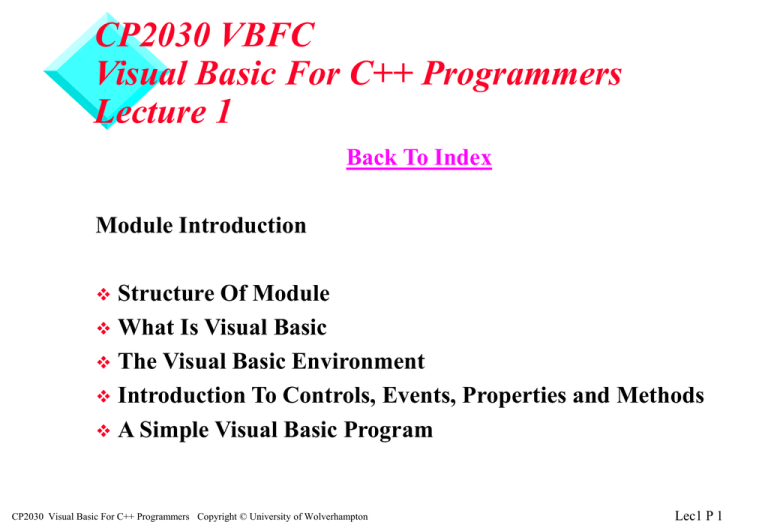
CP2030 VBFC Visual Basic For C++ Programmers Lecture 1 Back To Index Module Introduction Structure Of Module What Is Visual Basic The Visual Basic Environment Introduction To Controls, Events, Properties and Methods A Simple Visual Basic Program CP2030 Visual Basic For C++ Programmers Copyright © University of Wolverhampton Lec1 P 1 Introduction To The Module Staff Names D.I.Beardsmore MU401 1461 P.I.Wilson MU217 1806 CM1949 CP2030 Visual Basic For C++ Programmers Copyright © University of Wolverhampton CM1940 Lec1 P 2 Structure Of The Module Module consists of formal Lectures, Tutorials and Workshops Lectures - 2 hrs approx. Tutorials - 1 hour In most cases questions will be set - time will be made available for students to raise problems, and review lectures, etc Workshops - 1 hours Help with WS questions. Assessment sign offs. Notes will be provided CP2030 Visual Basic For C++ Programmers Copyright © University of Wolverhampton Lec1 P 3 Module Information Refer to the timetable for Workshops and Tutorials. WorkShop and Tutorial groups. IT IS IMPORTANT TO KEEP TO YOUR ALLOCATED GROUPS Book list : Visual Basic Quick Tutor - R Smythe An Intro To Programming Using Visual Basic 4 - D. Schneider Mastering VB - S.Saxon, D Saxon CP2030 Visual Basic For C++ Programmers Copyright © University of Wolverhampton Lec1 P 4 Module Assessment Assessment 70% Four Assessment questions. (Assessment 1 consists of a number of smaller questions) Examination 30% CP2030 Visual Basic For C++ Programmers Copyright © University of Wolverhampton Lec1 P 5 Aims of The Module Provides an introduction to Windows programming - event driven programming. Design AND Programming in a Graphical User Interface Environment Introduces many of the most widely used controls - enables students to fully develop a stand alone application. Develops professional programming skills Prepares students for industrial year CP2030 Visual Basic For C++ Programmers Copyright © University of Wolverhampton Lec1 P 6 The Visual Basic module set. CP1007 VB1 CP2028 VB2 CP2030 VB For C++ CP3013 App Dev in VB CP1000 S.P. in C++ CP2030 Visual Basic For C++ Programmers Copyright © University of Wolverhampton Lec1 P 7 What is Visual Basic? Event-driven programming language Powerful, Windows-based, screen designer..... ....linked to underlying functionality in subroutines/functions Increased functionality via third party VBX(Visual Basic Extension - 16 bit) and OCX (Object Linking and Embedding - 32 bit) Rapid application development CP2030 Visual Basic For C++ Programmers Copyright © University of Wolverhampton Lec1 P 8 Background to Visual Basic Beginners All-purpose Symbolic Instruction Code A simple programming language Developed in 1963 as a resident language Simple Language made it very popular Most machines have own version of BASIC DOS based (not windows) Many version developed GWBASIC, CPMBASIC,… MSQuickBASIC(1982) CP2030 Visual Basic For C++ Programmers Copyright © University of Wolverhampton Lec1 P 9 Windows Programming Visual Basic developed in-house at Microsoft Windows based Applications developed within an environment Powerful windows design for Graphical User Interfaces (GUIs). Simple but powerful coding language Quick to produce applications Currently the most popular language for Windows applications CP2030 Visual Basic For C++ Programmers Copyright © University of Wolverhampton Lec1 P 10 Differences between VB & C++ Students to add notes CP2030 Visual Basic For C++ Programmers Copyright © University of Wolverhampton Lec1 P 11 Similarities between VB & C++ Students to add notes CP2030 Visual Basic For C++ Programmers Copyright © University of Wolverhampton Lec1 P 12 Visual Basic Environment Components of the VB design environment? Menu Bar Project Window Control Toolbox Form CP2030 Visual Basic For C++ Programmers Copyright © University of Wolverhampton Properties Window Lec1 P 13 VB Environment: Menu Bar The Menu Bar consists of 3 elements the – Title Bar, which holds the name of application, default if Microsoft Visual Basic [design] – Menu Bar, this is the link to Visual Basic’s menu facilities, each menu option drops down into sub-menus – Toolbar, contains icons which give access to the more commonly used commands (which are also available through the menu bar) Title bar Menu Bar CP2030 Visual Basic For C++ Programmers Copyright © University of Wolverhampton Toolbar Lec1 P 14 VB Environment: Project Window CP2030 Visual Basic For C++ Programmers Copyright © University of Wolverhampton Lec1 P 15 VB Environment: Properties Window CP2030 Visual Basic For C++ Programmers Copyright © University of Wolverhampton Lec1 P 16 VB Environment: Control Toolbox Pointer Label Group Frame Check Box Combo Box Horizontal Scroll Bar Timer Directory List Box Picture Text Box Command Button Option/Radio Button List Box Vertical Scroll Bar Drive List Box File List Box Shape Line Image Data Control Common Dialog OLE CP2030 Visual Basic For C++ Programmers Copyright © University of Wolverhampton Grid Lec1 P 17 VB Environment: Context Sensitive Help Context sensitive help is very useful Select the item control that you want help on Press the F1 key F1 CP2030 Visual Basic For C++ Programmers Copyright © University of Wolverhampton Lec1 P 18 Visual Basic Program Overview Design Tools Screen Editor Toolbox Code Editor Control/Event Run/Debug Other tools: Paintbrush etc.. Property Box Colour Palette Menu Design Compiler/ Application CP2030 Visual Basic For C++ Programmers Copyright © University of Wolverhampton Third Party Controls VBX/OCX Lec1 P 19 Introduction To Controls, Events, Properties & Methods Controls - Processing Graphical objects which can be placed onto a form (window) – Controls have pre-defined ‘events’ eg. mouse click – Code can be attached to an event – When an event occurs if code has been attached it is executed, otherwise default processing takes place Controls - Properties – all controls have appropriate properties such as Height, Name, Colour – properties can be changed either at design-time or at run-time CP2030 Visual Basic For C++ Programmers Copyright © University of Wolverhampton Lec1 P 20 Visual Basic Events eg. Mouse Click, Key Press, Got Focus, Timer, etc. Control events are pre-determined by the programmer Each type of control has a relevant set of events Eg. Events that can happen to a command button CP2030 Visual Basic For C++ Programmers Copyright © University of Wolverhampton Lec1 P 21 Event Driven Programs In normal programming your application is always in control In GUI(Graphical User Interface) programming your applications provide a number of service routines which are triggered as required by the operating system Events happen to a control/object – mostly user generated events – controls themselves can also cause events Events are pre-set/pre-programmed CP2030 Visual Basic For C++ Programmers Copyright © University of Wolverhampton Lec1 P 22 Control - Form(s) At design stage controls are placed on the form During execution the form control acts like any other windowmaximize, minimize, etc An application can be make up from a number of forms Like all other controls the form has properties - caption name, size, colour, etc CP2030 Visual Basic For C++ Programmers Copyright © University of Wolverhampton Lec1 P 23 Events and Visual Basic Visual Basic is event-driven You start with your user interface by drawing graphical Controls on Forms You then add program code for each of these controls which will be run (or triggered) when a particular event is generated Example event: Command Button Click Trigger Event Code Executed CP2030 Visual Basic For C++ Programmers Copyright © University of Wolverhampton Lec1 P 24 Types of Events Events can be classified as: User generated – (e.g. command button click) Computer generated – (e.g. specific time elapsed, from a timer control) Program generated – (i.e. program explicitly generates an event from within the code) CP2030 Visual Basic For C++ Programmers Copyright © University of Wolverhampton Lec1 P 25 Controls Properties Properties describe the characteristics of a control, these can be – physical characteristics such as height, width and colour – or its current state such as enabled, or links definitions to other applications Note the name and caption properties of a control have the same default values but are actually different. – The name is what code uses to reference the control, whereas – the caption is purely what is written on the control so the user can identify it Good idea to rename controls to meaningful names Properties can be changed either at design time or at run time CP2030 Visual Basic For C++ Programmers Copyright © University of Wolverhampton Lec1 P 26 Changing Properties at Design Time By selecting the properties window properties can be set to values at design time A drop down list of the controls currently on the form, allows the selection of a control so its properties can be edited All the properties of that control are shown below, where they can be selected for editing The currently selected property of the selected control is shown in the edit window where it can be modified CP2030 Visual Basic For C++ Programmers Copyright © University of Wolverhampton Lec1 P 27 Changing Properties at Run Time To change a control’s property you assign the new property to it: Control Name Property Command1.Enabled = False Label1.ForeColor = QBColor(4) To access a control on another form you should use the form name to prefix the property name: Form Name Control Name Property Form1.Command1.Caption = “New Caption” CP2030 Visual Basic For C++ Programmers Copyright © University of Wolverhampton Lec1 P 28 Controls Methods A method is a routine which operates on a control, for example control_name.SetFocus would make control_name the currently selected control. There are many methods available, we will only use a few of them The Events, Properties and Methods for controls can be found under the controls description in Help. i.e. select a control then press F1 to get the help for a control. CP2030 Visual Basic For C++ Programmers Copyright © University of Wolverhampton Lec1 P 29 Controls - Label and Text Boxes Labels are used for text output : Titles, Messages, and Prompts - screen text that the user cannot change. eg. Label1.Caption = “Heading For Program 1” Text Boxes are used for both text input and output. eg. Text1.Text = “Output to Text box1” sName = Text2.Text (Text Input covered in week2) CP2030 Visual Basic For C++ Programmers Copyright © University of Wolverhampton Lec1 P 30 Control - Command Writing Code Under an Event When we want our program to do something we have to write code to do it, code is written under event procedures We have to decide the control and its event procedure we want the user to use to invoke the code Command buttons are often used to invoke code. Normally for command buttons we use their click event In actual fact you can write code for any event from any control. CP2030 Visual Basic For C++ Programmers Copyright © University of Wolverhampton Lec1 P 31 Developing a Simple VB Program Students to add notes CP2030 Visual Basic For C++ Programmers Copyright © University of Wolverhampton Lec1 P 32 Visual Basic Program Structure Project File – ‘.MAK’ Form Files – ‘.FRM’ – ‘.FRX’ Modules – ‘.BAS’ Custom Controls – ‘.VBX’ files Save As... – Possible problem... CP2030 Visual Basic For C++ Programmers Copyright © University of Wolverhampton Lec1 P 33 Saving The Project When you come to save the project you will be saving a number of files: – FORM1.FRM – PROJECT1.MAK the form itself the project make file The best way to organise your projects is by keeping each project in a separate directory. You can create new directories using file manager If you are working on the harddisk/network drive then you should make sure that you copy the files back onto your floppy disk when you’ve finished! CP2030 Visual Basic For C++ Programmers Copyright © University of Wolverhampton Lec1 P 34 Question Create an application to either display a students name with either First name followed by Second name OR Second name followed by first name. CP2030 Visual Basic For C++ Programmers Copyright © University of Wolverhampton Lec1 P 35
